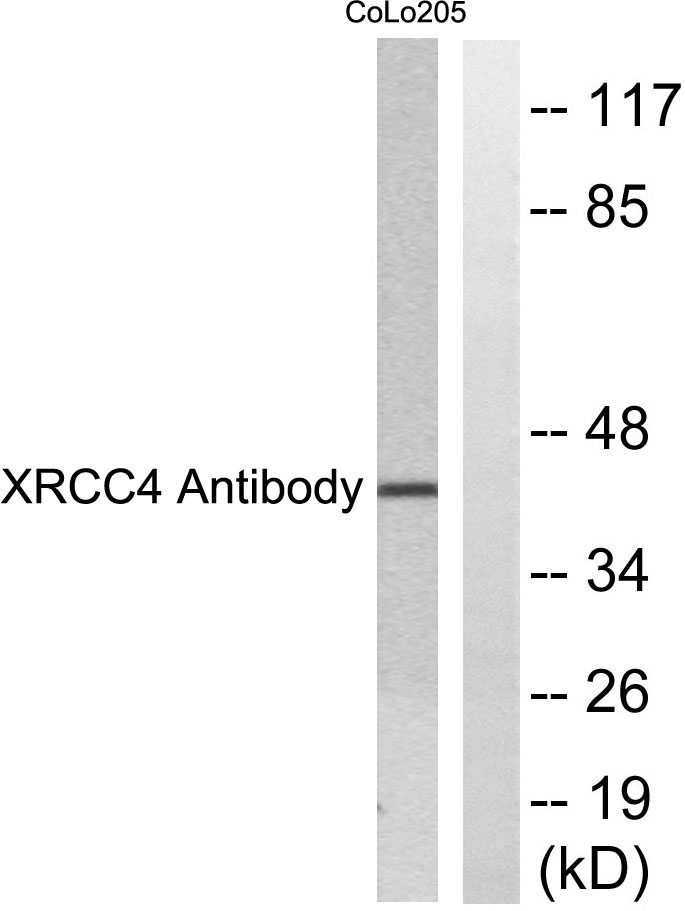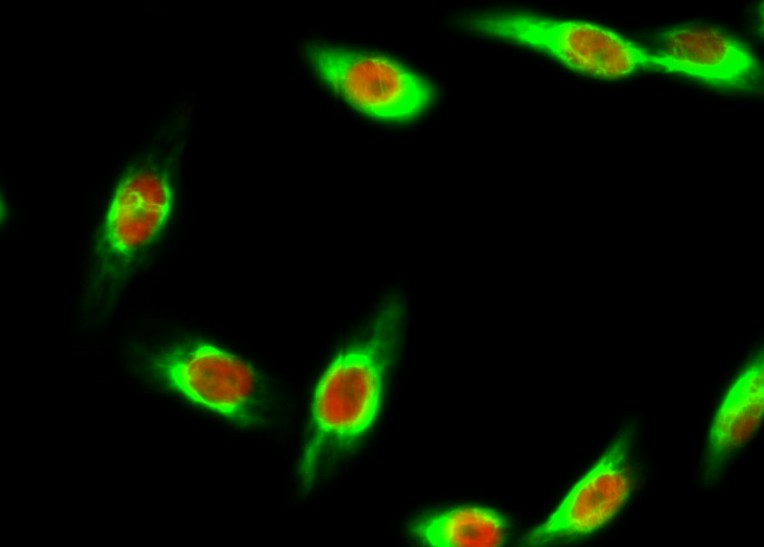XRCC4 Polyclonal Antibody
- Catalog No.:YT4921
- Applications:WB;ELISA
- Reactivity:Human;Mouse
- Target:
- XRCC4
- Fields:
- >>Non-homologous end-joining
- Gene Name:
- XRCC4
- Protein Name:
- DNA repair protein XRCC4
- Human Gene Id:
- 7518
- Human Swiss Prot No:
- Q13426
- Mouse Swiss Prot No:
- Q924T3
- Immunogen:
- The antiserum was produced against synthesized peptide derived from human XRCC4. AA range:261-310
- Specificity:
- XRCC4 Polyclonal Antibody detects endogenous levels of XRCC4 protein.
- Formulation:
- Liquid in PBS containing 50% glycerol, 0.5% BSA and 0.02% sodium azide.
- Source:
- Polyclonal, Rabbit,IgG
- Dilution:
- WB 1:500 - 1:2000. ELISA: 1:20000. Not yet tested in other applications.
- Purification:
- The antibody was affinity-purified from rabbit antiserum by affinity-chromatography using epitope-specific immunogen.
- Concentration:
- 1 mg/ml
- Storage Stability:
- -15°C to -25°C/1 year(Do not lower than -25°C)
- Other Name:
- XRCC4;DNA repair protein XRCC4;X-ray repair cross-complementing protein 4
- Observed Band(KD):
- 40kD
- Background:
- The protein encoded by this gene functions together with DNA ligase IV and the DNA-dependent protein kinase in the repair of DNA double-strand breaks. This protein plays a role in both non-homologous end joining and the completion of V(D)J recombination. Mutations in this gene can cause short stature, microcephaly, and endocrine dysfunction (SSMED). Alternative splicing generates several transcript variants. [provided by RefSeq, Dec 2015],
- Function:
- function:Involved in DNA non-homologous end joining (NHEJ) required for double-strand break repair and V(D)J recombination. Binds to DNA and to DNA ligase IV (LIG4). The LIG4-XRCC4 complex is responsible for the NHEJ ligation step, and XRCC4 enhances the joining activity of LIG4. Binding of the LIG4-XRCC4 complex to DNA ends is dependent on the assembly of the DNA-dependent protein kinase complex DNA-PK to these DNA ends.,PTM:Monoubiquitinated.,PTM:Phosphorylated by PRKDC. The phosphorylation seems not to be necessary for binding to DNA. Phosphorylation by CK2 promotes interaction with APTX.,PTM:Sumoylation at Lys-210 is required for nuclear localization and recombination efficiency. Has no effect on ubiquitination.,similarity:Belongs to the XRCC4 family.,subunit:Homodimer and homotetramer in solution. The homodimer associates with LIG4, and the LIG4-XRCC4 complex associates in a DNA-dep
- Subcellular Location:
- Nucleus . Chromosome . Localizes to site of double-strand breaks. .; [Protein XRCC4, C-terminus]: Cytoplasm . Translocates from the nucleus to the cytoplasm following cleavage by caspase-3 (CASP3). .
- Expression:
- Widely expressed.
- June 19-2018
- WESTERN IMMUNOBLOTTING PROTOCOL
- June 19-2018
- IMMUNOHISTOCHEMISTRY-PARAFFIN PROTOCOL
- June 19-2018
- IMMUNOFLUORESCENCE PROTOCOL
- September 08-2020
- FLOW-CYTOMEYRT-PROTOCOL
- May 20-2022
- Cell-Based ELISA│解您多样本WB检测之困扰
- July 13-2018
- CELL-BASED-ELISA-PROTOCOL-FOR-ACETYL-PROTEIN
- July 13-2018
- CELL-BASED-ELISA-PROTOCOL-FOR-PHOSPHO-PROTEIN
- July 13-2018
- Antibody-FAQs
- Products Images

- Western Blot analysis of various cells using XRCC4 Polyclonal Antibody. Secondary antibody(catalog#:RS0002) was diluted at 1:20000

- Western blot analysis of lysates from COLO205 cells, using XRCC4 Antibody. The lane on the right is blocked with the synthesized peptide.


